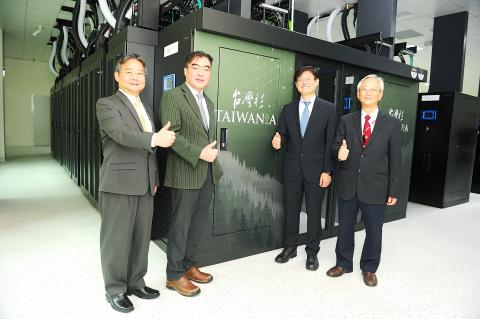The National Applied Research Laboratories (NARL) on Monday unveiled the Taiwania, the most powerful supercomputer that has yet been built indigenously for publicly funded research.
Operating at peak efficiency, Taiwania can perform up to 1.33 quadrillion floating-point operations per second (petaflops) and has 3.4 petabytes of storage, NARL National Center for High-Performance Computing official Lu Hung-fu (盧鴻復) said.
When the graphics processing units’ (GPU) capacity is added to the total computing power, Taiwania’s performance increases to 1.7 petaflops, he said.

Photo: Chien Hui-ju, Taipei Times
The supercomputer consists of 630 pure central processing units (CPUs) and 64 mixed central and graphics processing units, which boast a total of 25,200 Intel cores and 256 Nvidia P100 GPU accelators, he said.
The two-year program to build the cluster cost NT$430 million (US$14.44 million), he said.
The new supercomputer is vastly superior to the Advanced Large-scale Parallel Supercluster (ALPS) — also known as Windrider — that used to be the NARL’s most powerful cluster, he said.
Taiwania has seven times the processing power of ALPS, while its energy efficiency of 4 gigaflops per watt is an order of magnitude better, the center said.
Additionally, Taiwania’s high-density design is more volume-efficient at one-third the size of ALPS, the center said.
Taiwania is the first state-owned supercomputer to perform at petascale speeds and it was built to meet the high-performance computing needs of the nation’s research institutions, center director-general Shieh Ce-kuen said.
Taiwania has a wide range of practical applications in the simulation and analysis of complex phenomena, which facilitates biomedical research, such as gene or neurological pathway mapping, Hsieh said.
Taiwania’s computing ability will allow Taiwanese neuroscientists to scale up their neurological mapping studies from fruit fly brains of 130,000 neurons to mice brains of 70 million neurons, he said.
Such research could lead to faster medical diagnoses of hereditary conditions and deepen the understanding of neurological diseases, such as Parkinson’s and Alzheimer’s, he said.
Furthermore, Taiwania could be used for air pollution-related research and provide faster alerts for dangerous air quality conditions, he said.
Taiwania is scheduled to be activated today and private research groups may utilize the cluster for an hourly fee of NT$0.7, he said.
NARL is to decommission its older supercomputers ALPS, Iris and Formosa 5 by no later than September, he said.

The US government has signed defense cooperation agreements with Japan and the Philippines to boost the deterrence capabilities of countries in the first island chain, a report by the National Security Bureau (NSB) showed. The main countries on the first island chain include the two nations and Taiwan. The bureau is to present the report at a meeting of the legislature’s Foreign Affairs and National Defense Committee tomorrow. The US military has deployed Typhon missile systems to Japan’s Yamaguchi Prefecture and Zambales province in the Philippines during their joint military exercises. It has also installed NMESIS anti-ship systems in Japan’s Okinawa

‘WIN-WIN’: The Philippines, and central and eastern European countries are important potential drone cooperation partners, Minister of Foreign Affairs Lin Chia-lung said Minister of Foreign Affairs Lin Chia-lung (林佳龍) in an interview published yesterday confirmed that there are joint ventures between Taiwan and Poland in the drone industry. Lin made the remark in an exclusive interview with the Chinese-language Liberty Times (the Taipei Times’ sister paper). The government-backed Taiwan Excellence Drone International Business Opportunities Alliance and the Polish Chamber of Unmanned Systems on Wednesday last week signed a memorandum of understanding in Poland to develop a “non-China” supply chain for drones and work together on key technologies. Asked if Taiwan prioritized Poland among central and eastern European countries in drone collaboration, Lin

Renewed border fighting between Thailand and Cambodia showed no signs of abating yesterday, leaving hundreds of thousands of displaced people in both countries living in strained conditions as more flooded into temporary shelters. Reporters on the Thai side of the border heard sounds of outgoing, indirect fire yesterday. About 400,000 people have been evacuated from affected areas in Thailand and about 700 schools closed while fighting was ongoing in four border provinces, said Thai Rear Admiral Surasant Kongsiri, a spokesman for the military. Cambodia evacuated more than 127,000 villagers and closed hundreds of schools, the Thai Ministry of Defense said. Thailand’s military announced that

NO CONFIDENCE MOTION? The premier said that being toppled by the legislature for defending the Constitution would be a democratic badge of honor for him Premier Cho Jung-tai (卓榮泰) yesterday announced that the Cabinet would not countersign the amendments to the local revenue-sharing law passed by the Legislative Yuan last month. Cho said the decision not to countersign the amendments to the Act Governing the Allocation of Government Revenues and Expenditures (財政收支劃分法) was made in accordance with the Constitution. “The decision aims to safeguard our Constitution,” he said. The Constitution stipulates the president shall, in accordance with law, promulgate laws and issue mandates with the countersignature of the head of the Executive Yuan, or with the countersignatures of both the head of the Executive Yuan and ministers or